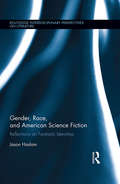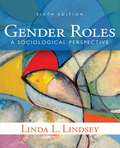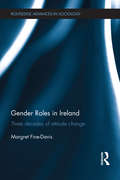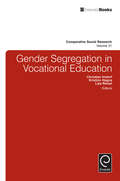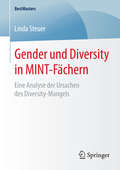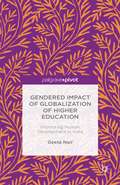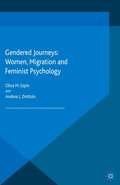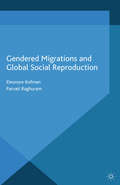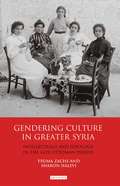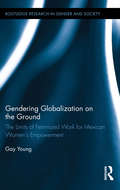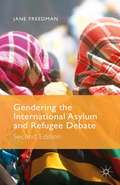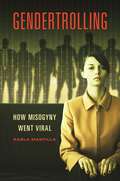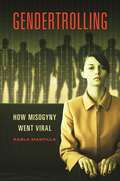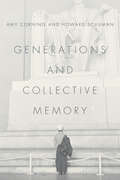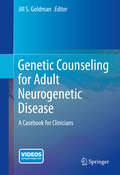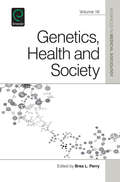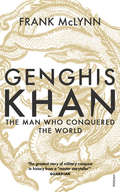- Table View
- List View
Gender, Race, and American Science Fiction: Reflections on Fantastic Identities (Routledge Interdisciplinary Perspectives on Literature)
by Jason HaslamThis book focuses on the interplay of gender, race, and their representation in American science fiction, from the nineteenth-century through to the twenty-first, and across a number of forms including literature and film. Haslam explores the reasons why SF provides such a rich medium for both the preservation of and challenges to dominant mythologies of gender and race. Defining SF linguistically and culturally, the study argues that this mode is not only able to illuminate the cultural and social histories of gender and race, but so too can it intervene in those histories, and highlight the ruptures present within them. The volume moves between material history and the linguistic nature of SF fantasies, from the specifics of race and gender at different points in American history to larger analyses of the socio-cultural functions of such identity categories. SF has already become central to discussions of humanity in the global capitalist age, and is increasingly the focus of feminist and critical race studies; in combining these earlier approaches, this book goes further, to demonstrate why SF must become central to our discussions of identity writ large, of the possibilities and failings of the human —past, present, and future. Focusing on the interplay of whiteness and its various 'others' in relation to competing gender constructs, chapters analyze works by Nathaniel Hawthorne, Mary E. Bradley Lane, Edgar Rice Burroughs, Philip Francis Nowlan, George S. Schuyler and the Wachowskis, Frank Herbert, William Gibson, and Octavia Butler. Academics and students interested in the study of Science Fiction, American literature and culture, and Whiteness Studies, as well as those engaged in critical gender and race studies, will find this volume invaluable.
Gender Roles: A Sociological Perspective
by Linda L LindseyOffers a sociological perspective of gender that can be applied to our lives. Focusing on the most recent research and theory–both in the U.S. and globally–Gender Roles, 6e provides an in-depth, survey and analysis of modern gender roles and issues from a sociological perspective. The text integrates insights and research from other disciplines such as biology, psychology, anthropology, and history to help build more robust theories of gender roles.
Gender Roles: A Sociological Perspective
by Linda L LindseyOffers a sociological perspective of gender that can be applied to our lives. Focusing on the most recent research and theory–both in the U.S. and globally–Gender Roles, 6e provides an in-depth, survey and analysis of modern gender roles and issues from a sociological perspective. The text integrates insights and research from other disciplines such as biology, psychology, anthropology, and history to help build more robust theories of gender roles.
Gender Roles in Ireland: Three Decades of Attitude Change (Routledge Advances in Sociology)
by Margret Fine-DavisGender Roles in Ireland: three decades of attitude change documents changing attitudes toward the role of women in Ireland from 1975 to 2005, a key period of social change in this society. The book presents replicated measures from four separate surveys carried out over three decades. These cover a wide range of gender role attitudes as well as key social issues concerning the role of women in Ireland, including equal pay, equal employment opportunity, maternal employment, contraception etc. Attitudes to abortion, divorce and moral issues are also presented and discussed in the context of people’s voting behaviour in national referenda. Taken together, the data available in these studies paint a detailed and complex picture of the evolving role of women in Ireland during a period of rapid social change and key developments in social legislation. The book brings the results up to the present by including new data on current gender role issues from Margret Fine-Davis' latest research.
Gender Roles in Ireland: Three Decades of Attitude Change (Routledge Advances in Sociology)
by Margret Fine-DavisGender Roles in Ireland: three decades of attitude change documents changing attitudes toward the role of women in Ireland from 1975 to 2005, a key period of social change in this society. The book presents replicated measures from four separate surveys carried out over three decades. These cover a wide range of gender role attitudes as well as key social issues concerning the role of women in Ireland, including equal pay, equal employment opportunity, maternal employment, contraception etc. Attitudes to abortion, divorce and moral issues are also presented and discussed in the context of people’s voting behaviour in national referenda. Taken together, the data available in these studies paint a detailed and complex picture of the evolving role of women in Ireland during a period of rapid social change and key developments in social legislation. The book brings the results up to the present by including new data on current gender role issues from Margret Fine-Davis' latest research.
Gender Segregation in Vocational Education (Comparative Social Research #31)
by Liza Reisel Kristinn Hegna Christian ImdorfThe gender segregated nature of vocational education (VET) has received little attention in the stratification literature, despite the well-known consequences of VET for differences in labour market outcomes, such as job placement, income and access to full-time employment. This book investigates the institutional contexts of gender segregation in VET from a comparative perspective, through a number of cross-national comparisons as well as more in-depth studies of Canada, Norway, Germany, Australia and Bulgaria.The various chapters tackle questions about occupational expectations, gendered pathways to applied fields of study, educational transitions, feminization of occupations and the relationship between educational choice and opportunity structures. We discuss the relationship between institutional contexts and gender-typing of educational programs, and whether VET system characteristics make a difference to occupational outcomes across countries. The book concludes with a chapter on education-to-employment transitions (based on a large scale comparative project on labour market entry) assessing the impact of vocational education on gendered labour market inequalities.
Gender und Diversity in MINT-Fächern: Eine Analyse der Ursachen des Diversity-Mangels (BestMasters)
by Linda SteuerLinda Steuer erörtert anhand eines Ursachen-Modells die Ursprünge und Einflussfaktoren für den Mangel an Frauen in MINT-Berufen. Sie zeigt, inwieweit die im Zuge des Modells entwickelten Erkenntnisse in aktuellen Maßnahmen und MINT-Programmen berücksichtigt werden, sowie ob ein Erfolg aus jenen abgeleitet und erwartet werden kann. Basierend auf den Forschungsergebnissen sowie der Analyse aktueller Programme werden Implikationen und Handlungsmöglichkeiten für Wissenschaft und Praxis vorgestellt.
Gendered Impact of Globalization of Higher Education: Promoting Human Development in India
by Geeta NairThis book explores the significant role education plays in the promotion of human development and gender equality in India, situating this progression in relation to developed nations, the other BRIC countries and the ongoing attainment of the Millennium Development Goals.
Gendered Journeys: Women, Migration and Feminist Psychology
by Oliva M. EspínThis book brings a psychological perspective to the often overlooked and understudied topic of women's experiences of migration, covering topics such as memory, place, language, race, social class, work, violence, motherhood, and intergenerational impact of migration.
Gendered Migrations and Global Social Reproduction (Migration, Diasporas and Citizenship)
by E. Kofman P. RaghuramEleonore Kofman and Parvati Raghuram argue for the benefits of social reproduction as a lens through which to understand gendered transformations in global migration. They highlight the range of sites, sectors, and skills in which migrants are employed and how migration is both a cause and an outcome of depletion in social reproduction.
Gendering Culture in Greater Syria: Intellectuals and Ideology in the Late Ottoman Period (Library of Middle East History)
by Fruma Zachs Sharon HaleviThe Nahda (lit. 'the Awakening') was one of the most significant cultural movements in modern Arab history. By focusing on the neglected role of women in the intellectual Islamic renaissance of the late Ottoman Period, Fruma Zachs and Sharon Halevi provide a refreshingly interdisciplinary exploration of gender and culture in the Arab World. Focusing mainly on Greater Syria, this book re-examines the cultural by-products of the Nahda - such as scientific debates, journal articles, essays, short stories and novels - and provides a new framework for rethinking the dynamics of cultural and social change in what today we know as Syria and Lebanon. The lasting impact of the Nahda is given an innovative and thoroughly unique interpretation, providing an indispensable perspective to studying the nuanced roles of the construction and development of gender ideologies in the nineteenth century Middle East. The authors explore contemporary ideas concerning modern gender roles in the Middle East, and the extent to which these emerged in nineteenth-century Greater Syria. How were these ideas incorporated into daily lives, consumer patterns and cultural activities?Was class a determining factor in the creation of gender relations in the Muslim world? How were the subjectivities of gender moulded and articulated in fictional and non-fictional texts? The authors delineate both the evolution of a discourse on gender as well the "real-life" activities of men and women as writers, readers and participants in philanthropic and cultural societies, literary salons and educational enterprises. This book reemphasizes the position of the Nahda in the worlds of Damascus, Aleppo and Beirut as an innovative, deeply influential, and significant socio-cultural and political movement in its own right, which played a major role in shaping modern Arab culture, worldviews and self-perception. Zachs and Halevi here provide a new framework for rethinking the dynamics of cultural and social change, and present a groundbreaking new interpretation of the cumulative impact of the Nahda on gender perception in the late Ottoman Period.
Gendering Globalization on the Ground: The Limits of Feminized Work for Mexican Women’s Empowerment (Routledge Research in Gender and Society #44)
by Gay YoungHow has globalization worked for women working on the frontlines of neoliberalism on the Mexico-US border? This border divides "US" from "Others," and produces social inequalities that form a site where marginalized border women encounter the othering power of neoliberalism and confront inequalities of gender and class. Within this context, a critical comparison of socially similar women, working either in export production industries or in small-scale commerce and low-level services in Ciudad Juárez, reveals how export factory work constrains women’s empowerment at home – as well as the wages they earn and the well-being of their households. This volume challenges the neoliberal rationale of "empowering" women to support market growth, and argues instead for understanding women’s empowerment as a process of transformation from disempowerment by gender power relations to challenging masculinist domination in households and, ultimately, the economy and society. Because structures of gender and globalization are mutually constituted, women’s empowerment as gender democracy is integral to producing alternative, democratic globalization. Using a feminist methodology that gives attention to the standpoint of women located on the downside of social hierarchies and takes into account strategically diverse points of view, this study develops analysis to counter neoliberal globalization as it touches down in the lives of ordinary women and men on the border and beyond.
Gendering Globalization on the Ground: The Limits of Feminized Work for Mexican Women’s Empowerment (Routledge Research in Gender and Society)
by Gay YoungHow has globalization worked for women working on the frontlines of neoliberalism on the Mexico-US border? This border divides "US" from "Others," and produces social inequalities that form a site where marginalized border women encounter the othering power of neoliberalism and confront inequalities of gender and class. Within this context, a critical comparison of socially similar women, working either in export production industries or in small-scale commerce and low-level services in Ciudad Juárez, reveals how export factory work constrains women’s empowerment at home – as well as the wages they earn and the well-being of their households. This volume challenges the neoliberal rationale of "empowering" women to support market growth, and argues instead for understanding women’s empowerment as a process of transformation from disempowerment by gender power relations to challenging masculinist domination in households and, ultimately, the economy and society. Because structures of gender and globalization are mutually constituted, women’s empowerment as gender democracy is integral to producing alternative, democratic globalization. Using a feminist methodology that gives attention to the standpoint of women located on the downside of social hierarchies and takes into account strategically diverse points of view, this study develops analysis to counter neoliberal globalization as it touches down in the lives of ordinary women and men on the border and beyond.
Gendering the International Asylum and Refugee Debate: Second Edition
by J. FreedmanThis revised and updated 2nd edition of Freedman's hard-hitting study aims to remedy the current lack of gender-specific analyses of asylum and refugee issues. It provides a comprehensive account of the situation of women in global forced migration, and explains the ways in which women's experiences are shaped by gendered relations and structures.
Gendertrolling: How Misogyny Went Viral
by Karla MantillaGendertrolling arises out of the same misogyny that fuels other "real life" forms of harassment and abuse of women. This book explains this phenomenon, the way it can impact women's lives, and how it can be stopped.Designed to educate the general public on a popular and brutal form of harassment against women, Gendertrolling: How Misogyny Went Viral provides key insight into this Internet phenomenon. The book not only differentiates this violent form of trolling from others but also discusses the legal parameters surrounding the issue, such as privacy, anonymity, and free speech online as well as offering legal and policy recommendations for improving the climate for women online.The analysis of social media and legal aspects of the book make it highly suitable as a reliable source to many modern classes. Additionally, increased awareness among the general and scholarly public of the phenomenon of gendertrolling would help galvanize widespread support for laws, policies, new online content provider protocols, and positive social pressure.
Gendertrolling: How Misogyny Went Viral
by Karla MantillaGendertrolling arises out of the same misogyny that fuels other "real life" forms of harassment and abuse of women. This book explains this phenomenon, the way it can impact women's lives, and how it can be stopped.Designed to educate the general public on a popular and brutal form of harassment against women, Gendertrolling: How Misogyny Went Viral provides key insight into this Internet phenomenon. The book not only differentiates this violent form of trolling from others but also discusses the legal parameters surrounding the issue, such as privacy, anonymity, and free speech online as well as offering legal and policy recommendations for improving the climate for women online.The analysis of social media and legal aspects of the book make it highly suitable as a reliable source to many modern classes. Additionally, increased awareness among the general and scholarly public of the phenomenon of gendertrolling would help galvanize widespread support for laws, policies, new online content provider protocols, and positive social pressure.
Generations and Collective Memory
by Amy Corning Howard SchumanWhen discussing large social trends or experiences, we tend to group people into generations. But what does it mean to be part of a generation, and what gives that group meaning and coherence? It's collective memory, say Amy Corning and Howard Schuman, and in Generations and Collective Memory, they draw on an impressive range of research to show how generations share memories of formative experiences, and how understanding the way those memories form and change can help us understand society and history. Their key finding—built on historical research and interviews in the United States and seven other countries (including China, Japan, Germany, Lithuania, Russia, Israel, and Ukraine)—is that our most powerful generational memories are of shared experiences in adolescence and early adulthood, like the 1963 Kennedy assassination for those born in the 1950s or the fall of the Berlin Wall for young people in 1989. But there are exceptions to that rule, and they're significant: Corning and Schuman find that epochal events in a country, like revolutions, override the expected effects of age, affecting citizens of all ages with a similar power and lasting intensity. The picture Corning and Schuman paint of collective memory and its formation is fascinating on its face, but it also offers intriguing new ways to think about the rise and fall of historical reputations and attitudes toward political issues.
Generations and Collective Memory
by Amy Corning Howard SchumanWhen discussing large social trends or experiences, we tend to group people into generations. But what does it mean to be part of a generation, and what gives that group meaning and coherence? It's collective memory, say Amy Corning and Howard Schuman, and in Generations and Collective Memory, they draw on an impressive range of research to show how generations share memories of formative experiences, and how understanding the way those memories form and change can help us understand society and history. Their key finding—built on historical research and interviews in the United States and seven other countries (including China, Japan, Germany, Lithuania, Russia, Israel, and Ukraine)—is that our most powerful generational memories are of shared experiences in adolescence and early adulthood, like the 1963 Kennedy assassination for those born in the 1950s or the fall of the Berlin Wall for young people in 1989. But there are exceptions to that rule, and they're significant: Corning and Schuman find that epochal events in a country, like revolutions, override the expected effects of age, affecting citizens of all ages with a similar power and lasting intensity. The picture Corning and Schuman paint of collective memory and its formation is fascinating on its face, but it also offers intriguing new ways to think about the rise and fall of historical reputations and attitudes toward political issues.
Generations and Collective Memory
by Amy Corning Howard SchumanWhen discussing large social trends or experiences, we tend to group people into generations. But what does it mean to be part of a generation, and what gives that group meaning and coherence? It's collective memory, say Amy Corning and Howard Schuman, and in Generations and Collective Memory, they draw on an impressive range of research to show how generations share memories of formative experiences, and how understanding the way those memories form and change can help us understand society and history. Their key finding—built on historical research and interviews in the United States and seven other countries (including China, Japan, Germany, Lithuania, Russia, Israel, and Ukraine)—is that our most powerful generational memories are of shared experiences in adolescence and early adulthood, like the 1963 Kennedy assassination for those born in the 1950s or the fall of the Berlin Wall for young people in 1989. But there are exceptions to that rule, and they're significant: Corning and Schuman find that epochal events in a country, like revolutions, override the expected effects of age, affecting citizens of all ages with a similar power and lasting intensity. The picture Corning and Schuman paint of collective memory and its formation is fascinating on its face, but it also offers intriguing new ways to think about the rise and fall of historical reputations and attitudes toward political issues.
Generations and Collective Memory
by Amy Corning Howard SchumanWhen discussing large social trends or experiences, we tend to group people into generations. But what does it mean to be part of a generation, and what gives that group meaning and coherence? It's collective memory, say Amy Corning and Howard Schuman, and in Generations and Collective Memory, they draw on an impressive range of research to show how generations share memories of formative experiences, and how understanding the way those memories form and change can help us understand society and history. Their key finding—built on historical research and interviews in the United States and seven other countries (including China, Japan, Germany, Lithuania, Russia, Israel, and Ukraine)—is that our most powerful generational memories are of shared experiences in adolescence and early adulthood, like the 1963 Kennedy assassination for those born in the 1950s or the fall of the Berlin Wall for young people in 1989. But there are exceptions to that rule, and they're significant: Corning and Schuman find that epochal events in a country, like revolutions, override the expected effects of age, affecting citizens of all ages with a similar power and lasting intensity. The picture Corning and Schuman paint of collective memory and its formation is fascinating on its face, but it also offers intriguing new ways to think about the rise and fall of historical reputations and attitudes toward political issues.
Generations and Collective Memory
by Amy Corning Howard SchumanWhen discussing large social trends or experiences, we tend to group people into generations. But what does it mean to be part of a generation, and what gives that group meaning and coherence? It's collective memory, say Amy Corning and Howard Schuman, and in Generations and Collective Memory, they draw on an impressive range of research to show how generations share memories of formative experiences, and how understanding the way those memories form and change can help us understand society and history. Their key finding—built on historical research and interviews in the United States and seven other countries (including China, Japan, Germany, Lithuania, Russia, Israel, and Ukraine)—is that our most powerful generational memories are of shared experiences in adolescence and early adulthood, like the 1963 Kennedy assassination for those born in the 1950s or the fall of the Berlin Wall for young people in 1989. But there are exceptions to that rule, and they're significant: Corning and Schuman find that epochal events in a country, like revolutions, override the expected effects of age, affecting citizens of all ages with a similar power and lasting intensity. The picture Corning and Schuman paint of collective memory and its formation is fascinating on its face, but it also offers intriguing new ways to think about the rise and fall of historical reputations and attitudes toward political issues.
Generations and Collective Memory
by Amy Corning Howard SchumanWhen discussing large social trends or experiences, we tend to group people into generations. But what does it mean to be part of a generation, and what gives that group meaning and coherence? It's collective memory, say Amy Corning and Howard Schuman, and in Generations and Collective Memory, they draw on an impressive range of research to show how generations share memories of formative experiences, and how understanding the way those memories form and change can help us understand society and history. Their key finding—built on historical research and interviews in the United States and seven other countries (including China, Japan, Germany, Lithuania, Russia, Israel, and Ukraine)—is that our most powerful generational memories are of shared experiences in adolescence and early adulthood, like the 1963 Kennedy assassination for those born in the 1950s or the fall of the Berlin Wall for young people in 1989. But there are exceptions to that rule, and they're significant: Corning and Schuman find that epochal events in a country, like revolutions, override the expected effects of age, affecting citizens of all ages with a similar power and lasting intensity. The picture Corning and Schuman paint of collective memory and its formation is fascinating on its face, but it also offers intriguing new ways to think about the rise and fall of historical reputations and attitudes toward political issues.
Genetic Counseling for Adult Neurogenetic Disease: A Casebook for Clinicians
by Jill S. GoldmanThe adult patient diagnosed with or at risk for a neurogenetic disease has many questions and concerns for the genetic counselor, the neurologist, and other practitioners. Because of the emotional and potentially life-altering impact of these diseases on the patient and family, counseling can be especially challenging.A rare hands-on guide to the subject, Genetic Counseling for Adult Neurogenetic Disease deals with core issues that differentiate adult neurogenetic counseling from its more familiar pediatric counterpart. This innovative book with accompanying videos is designed to fill in deficits in this area typical of training programs in genetic counseling (which have pediatrics and prenatal concentrations) and neurology (which rarely cover genetic counseling). For each condition featured, chapters include a detailed overview of genetic symptoms, diagnostic criteria, and management, plus guidelines for asking, and answering, pertinent questions. The major concentration, however, is on genetic counseling issues and case histories illustrating these issues. As an added dimension, the accompanying videos depict representative issues and challenges in genetic counseling for specific diseases in addition to the basics of a neurological examination. Among the conditions discussed:Movement disorders, including Parkinson's disease.Dementias, including Alzheimer's disease.Stroke.Motor neuron diseases.Neuropathies and channelopathies.Adult muscular dystrophies.Neurocutaneous syndromes.Plus a section on neurological and neuropsychological evaluation.This is information that will stay relevant as technologies change and genetic understanding evolves. Genetic Counseling for Adult Neurogenetic Disease offers advanced clinical wisdom for genetic counselors as well as neurologists, neuropsychologists, and other referring clinicians.
Genetics, Health, and Society (Advances in Medical Sociology #16)
by Brea L. PerryThis volume focuses on critical issues surrounding the intersection of genetics, health, and society. It provides a critical examination of sociological and biomedical approaches to genomics, including strengths and limitations of each perspective.
Genghis Khan: The Man Who Conquered the World
by Frank McLynnGenghis Khan was by far the greatest conqueror the world has ever known, whose empire stretched from the Pacific Ocean to central Europe, including all of China, the Middle East and Russia. So how did an illiterate nomad rise to such colossal power, eclipsing Alexander the Great, Julius Caesar and Napoleon? Credited by some with paving the way for the Renaissance, condemned by others for being the most heinous murderer in history, who was Genghis Khan? His actual name was Temujin, and the story of his success is that of the Mongol people: a loose collection of fractious tribes who tended livestock, considered bathing taboo and possessed an unparallelled genius for horseback warfare. United under Genghis, a strategist of astonishing cunning and versatility, they could dominate any sedentary society they chose.Combining fast-paced accounts of battles with rich cultural background and the latest scholarship, Frank McLynn brings vividly to life the strange world of the Mongols, describes Temujin’s rise from boyhood outcast to become Genghis Khan, and provides the most accurate and absorbing account yet of one of the most powerful men ever to have lived.
